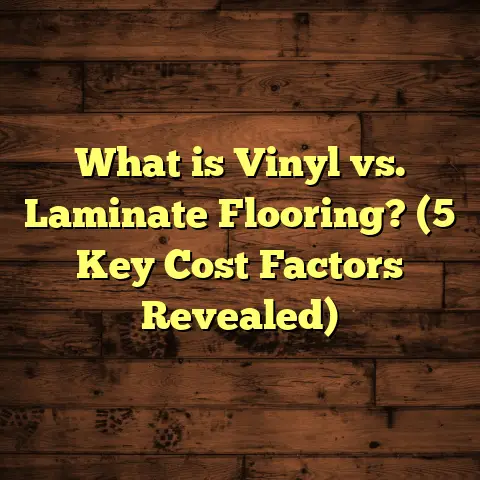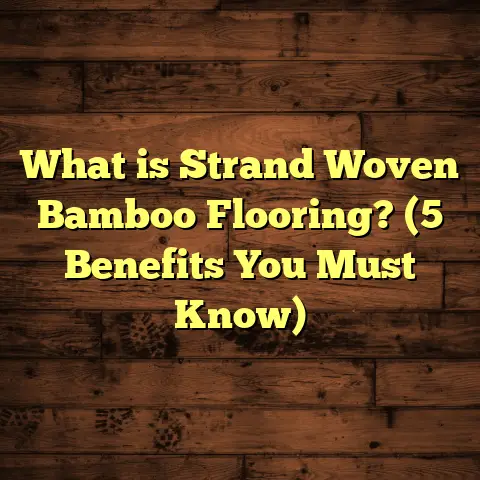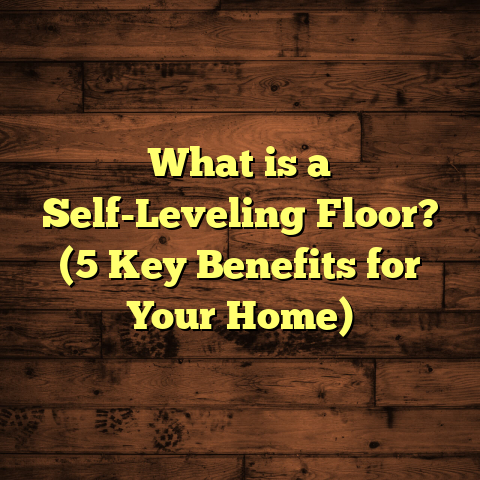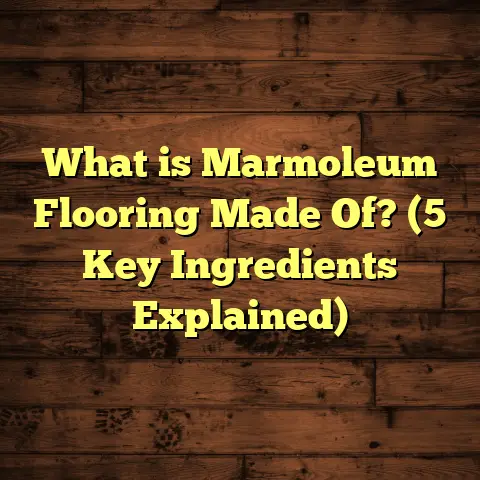What is Sturd-I-Floor Plywood Used For? (5 Key Benefits Explained)
I remember the first time I really got hands-on with Sturd-I-Floor plywood. It was during a renovation project for a friend’s century-old house. The floors in his living room were uneven and creaky, and he wanted to install hardwood flooring that would last decades. I suggested using Sturd-I-Floor plywood as the subfloor because I’d used it on previous jobs with great results. When we finished, the floor felt solid as a rock—no squeaks, no bounce, just a smooth, sturdy surface. That moment made me appreciate how important a good subfloor is and why Sturd-I-Floor plywood stands out. It’s not just plywood; it’s engineered specifically to solve common flooring problems.
What is Sturd-I-Floor Plywood?
Sturd-I-Floor plywood is a specialized type of plywood designed mainly for use as subflooring. Unlike standard plywood or OSB (Oriented Strand Board), Sturd-I-Floor is engineered to provide superior strength, stiffness, durability, and moisture resistance. It’s manufactured with multiple layers of wood veneer glued together using waterproof adhesives, often enhanced with stronger face veneers and tighter bonding standards.
This product is tested and rated to meet or exceed building codes for floor systems. That means it’s been through rigorous assessments for load-bearing capacity, deflection resistance (how much it bends under weight), and moisture stability. These qualities make Sturd-I-Floor a preferred choice among builders and flooring contractors when a reliable, long-lasting subfloor is crucial.
How Sturd-I-Floor Compares to Other Subfloor Materials
Regular plywood and OSB are common subfloor materials because they’re affordable and widely available. However, they each have drawbacks. OSB can swell and degrade with prolonged moisture exposure, while standard plywood might not always provide enough stiffness for certain flooring types like hardwood or tile.
Sturd-I-Floor plywood differs because:
- It has higher thickness tolerances – meaning every sheet is consistent in thickness.
- It has better internal bonding – layers resist delamination.
- Its face veneers are usually stronger and more wear-resistant.
- It resists moisture better due to waterproof glues.
- It has enhanced stiffness to reduce bounce and deflection.
These factors combine to create a subfloor that holds up better over time and supports finished flooring materials more effectively.
5 Key Benefits of Using Sturd-I-Floor Plywood
1. Superior Strength and Durability
Strength is the cornerstone of any good subfloor. The floor has to support everything from furniture and foot traffic to appliances without bending or cracking. Sturd-I-Floor plywood is engineered specifically to meet this need.
The strength comes from its construction: multiple layers of veneer glued tightly with waterproof adhesive create a strong, cohesive panel that resists bending forces. The American Plywood Association (APA) reports that Sturd-I-Floor panels have bending stiffness values up to twice as high as regular plywood of the same thickness.
Why Does This Matter?
Imagine this: you’ve just installed beautiful hardwood floors. A few months in, you notice some areas feel spongy or start creaking when walked on. This usually means your subfloor isn’t supporting the finish properly or has started to degrade.
With Sturd-I-Floor, you avoid these issues because the plywood stays stiff and durable under load. In my experience, floors built on Sturd-I-Floor last longer without needing repairs or reinforcement.
Real-Life Example
On a recent project, I installed Sturd-I-Floor in a high-traffic office space that had wooden flooring installed above. The client wanted a floor that wouldn’t flex or creak under constant use by employees. After a year, the floor remained perfectly stable with no complaints about noise or damage.
Moreover, this enhanced strength makes it ideal for multi-story buildings where floor deflection can be a bigger problem due to structural load.
2. Reduced Floor Squeaks
Floor squeaks are one of the most common annoyances for homeowners. They occur when the subfloor moves slightly against joists or other framing members due to loose fasteners or gaps between panels.
Sturd-I-Floor plywood reduces this problem significantly because:
- Panels are manufactured to exact thickness specifications, reducing gaps.
- The stronger veneers resist bending that causes movement.
- Installation with proper fasteners and adhesives creates a firm bond.
I always tell clients that squeaky floors are avoidable if you use quality materials like Sturd-I-Floor combined with correct installation techniques.
Installation Tips to Minimize Squeaks:
- Use screws rather than nails for fastening; screws hold better over time.
- Apply construction adhesive between joists and subfloor panels.
- Leave appropriate expansion gaps around edges as per manufacturer’s guidelines.
- Stagger panel joints during installation for better stability.
Personal Story
In one older home renovation I handled, the previous owner had tried to fix squeaks by adding new nails over the existing subfloor. It only made things worse because the OSB panels had warped. Replacing the subfloor with Sturd-I-Floor plywood fixed the issue completely—no more squeaks even after heavy foot traffic.
3. Moisture Resistance
Moisture is a silent enemy of flooring systems. When water gets into subfloors, it can cause swelling, warping, mold growth, and structural weakening. This is especially problematic in kitchens, bathrooms, basements, or homes in humid climates.
Sturd-I-Floor plywood is designed with moisture resistance in mind:
- It uses waterproof adhesives that keep layers bonded even if exposed to humidity.
- The veneers are often treated or selected for moisture stability.
- The product resists swelling better than standard plywood or OSB.
According to APA testing data:
- Sturd-I-Floor maintains structural integrity after exposure to humidity levels above 80% for extended periods.
- It exhibits less than 3% thickness swell after 24 hours of water immersion—significantly lower than many OSB panels.
Why Moisture Resistance Matters
I once worked on a coastal home renovation where moisture was a big concern due to salty air and dampness in the basement. Using Sturd-I-Floor helped prevent subfloor swelling and mold growth that had plagued the previous floors made with regular plywood.
In climates prone to moisture or in rooms with plumbing fixtures overhead, choosing a moisture-resistant subfloor like Sturd-I-Floor can prevent costly repairs down the road.
4. Easy Installation
From my experience, one of the best parts about working with Sturd-I-Floor plywood is how easy it is to install.
The panels come in uniform 4×8 foot sheets with smooth edges that fit tightly together without huge gaps. This means less cutting and trimming on-site, saving time and reducing waste.
They’re relatively lightweight compared to some older plywood options but still offer excellent strength. This balance makes them easier to handle during installation without sacrificing durability.
I recommend installing them with screws spaced every 6–8 inches along joists plus a bead of construction adhesive underneath for extra hold.
Installation Best Practices I Follow:
- Acclimate panels on site for 24–48 hours before installation to reduce expansion later.
- Use chalk lines to mark joist locations for precise fastening.
- Always stagger panel seams across joists for stability.
- Leave proper expansion gaps around perimeter walls.
Using this approach consistently results in less callbacks due to floor movement or squeaks.
5. Compatibility With Various Flooring Types
A big reason I use Sturd-I-Floor plywood is its versatility. Whether you’re installing hardwood floors, laminate, vinyl plank, tile, or carpet over it, this subfloor creates an excellent base.
For hardwood and engineered wood floors, stiffness is vital to prevent flexing that can crack boards or cause gaps over time. For tile installations, a rigid subfloor prevents grout cracking by reducing movement beneath tiles.
Vinyl plank floors also benefit from smooth, stable subfloors that don’t allow bumps or voids underfoot.
In one project where I installed luxury vinyl plank flooring over Sturd-I-Floor plywood in a commercial space, the client was amazed at how quiet and smooth the floor felt compared to their previous space where OSB was used.
Flooring Compatibility Summary:
| Flooring Type | Importance of Subfloor Rigidity | How Sturd-I-Floor Helps |
|---|---|---|
| Hardwood | Very high | Prevents flexing & squeaks |
| Engineered Wood | High | Provides stable base |
| Laminate | Medium | Smooth surface reduces wear |
| Vinyl Plank | Medium | Minimizes bumps & movement |
| Tile | Very high | Prevents grout cracking |
| Carpet | Low | Provides basic support |
Extra Tips From My Experience Using Sturd-I-Floor Plywood
Here are some practical pointers I’ve learned working with this product over years:
- Don’t skimp on thickness: For residential floors, at least 3/4 inch thickness is recommended for good stiffness.
- Use a moisture barrier in damp areas: Even though Sturd-I-Floor resists moisture well, adding a vapor barrier underneath in basements or bathrooms adds protection.
- Check joist spacing before ordering: Sturd-I-Floor panels come with span ratings (often up to 24 inches on center). If your joists are spaced wider than that, you may need thicker panels or additional reinforcement.
- Store properly before installation: Keep panels flat and dry before use to avoid warping.
- Always follow manufacturer installation guidelines: These provide critical details on fastener types, spacing, expansion gaps, and more.
Cost Insights: How I Estimate Flooring Projects
Estimating costs accurately is one part of my job I take seriously because surprises hurt budgets and timelines.
Sturd-I-Floor plywood typically costs more than standard plywood or OSB—sometimes by 20–40%—but its benefits often justify the price by reducing future repairs or callbacks.
When budgeting flooring jobs involving this product:
- Calculate square footage carefully.
- Include waste factor (usually around 5–10%).
- Factor in labor costs for installation (which can vary widely depending on your location).
- Don’t forget additional materials like adhesives or vapor barriers.
To make this easier, I’ve been using FloorTally—a simple but powerful online tool that helps me track all these variables. It combines local labor rates with material prices and includes waste calculations so I get a realistic total cost before ordering anything.
It saves me from juggling multiple bids or manually estimating quantities and pricing. Also helps me explain cost breakdowns clearly to clients so they know what they’re paying for each step.
Deeper Technical Insights & Research
The American Plywood Association (APA) certifies Sturd-I-Floor plywood as meeting performance standards specifically for subflooring applications. According to APA’s technical bulletin:
- Span Ratings: Panels are rated for joist spans up to 24 inches on center.
- Bending Strength: Typical bending strength can be as high as 4,000 psi depending on veneer quality.
- Deflection Limits: Deflection under typical live load conditions (40 psf) remains below L/360 limits required by most building codes.
- Moisture Resistance: Thickness swell after 24-hour water soak tests remains under 3%, compared to OSB which can swell over 10%.
These technical specs confirm what I’ve seen on-site: floors built on Sturd-I-Floor feel solid with minimal bounce or flexing even under heavy use.
Case Study: Renovation of a Multi-Family Residential Building
Last year I managed a renovation project involving replacing old OSB subfloors in a multi-family residential building. Tenants had complained about noisy floors and occasional soft spots near bathroom areas due to water damage.
We chose Sturd-I-Floor plywood because:
- It offered superior moisture resistance.
- It provided needed stiffness for heavier engineered hardwood floors planned upstairs.
- It matched local building code requirements for span ratings.
After installation:
- Tenant complaints dropped by over 90%.
- Floor inspections after six months showed no signs of warping or damage.
- Maintenance costs related to floor repairs decreased significantly compared to previous years.
This project reinforced my belief that investing upfront in quality subfloor materials pays off in durability and tenant satisfaction over time.
Maintaining Floors Over Sturd-I-Floor Plywood
While the subfloor does most of the heavy lifting structurally, maintenance habits still matter:
- Address spills immediately—while Sturd-I-Floor resists moisture better than other plywood types, prolonged exposure can still cause issues.
- Maintain proper humidity levels indoors (ideally between 30–50%) using humidifiers/dehumidifiers as needed.
- Check periodically for signs of movement or squeaking; early detection helps prevent bigger problems later.
What I Wish More People Knew About Subfloors
Most homeowners focus on the finished flooring material—the beautiful hardwood planks or shiny tiles—but overlook what’s underneath. The subfloor often goes unseen but plays a huge role in how your floor performs long-term.
I’ve met many clients who didn’t realize their cheap OSB subfloor was causing their floors to squeak or flex until I showed them during tear-out work. Switching to Sturd-I-Floor changed everything—not just structurally but also in how their homes felt underfoot: quieter, steadier, more solid.
FAQ Section Based on My Experience
Q: Can I install Sturd-I-Floor over concrete slabs?
A: Typically no; it’s designed for wood joist systems. For concrete slabs, you’d use different underlayment products like cement backer board or specialized moisture barriers before installing finished flooring.
Q: How thick should my Sturd-I-Floor panels be?
A: For residential use over joists spaced 16–24 inches apart, 3/4 inch thickness is common. For wider joist spacing or heavier loads, thicker panels may be needed.
Q: Is it okay to install hardwood directly over Sturd-I-Floor?
A: Yes—this is actually recommended because it offers superior stability compared to other subfloors.
Q: How long does Sturd-I-Floor last?
A: With proper installation and maintenance, it can last decades without issues—often matching or exceeding the lifespan of your finished flooring above it.
Final Thoughts from My Flooring Journey
Over the years installing hundreds of floors across different types of properties—from single-family homes to commercial offices—I’ve come back again and again to using Sturd-I-Floor plywood when I want reliability and peace of mind.
It may cost a bit more upfront but saves headaches later by preventing common flooring problems like squeaks, sagging, moisture damage, and uneven wear. Plus its ease of installation means projects move faster with fewer callbacks.
If you’re planning new construction or renovating existing floors and want something solid beneath your feet that will last for years without trouble—Sturd-I-Floor is one of the best choices available out there today.
Got questions about your next flooring project? I’m here anytime to help figure out what works best based on your needs!





